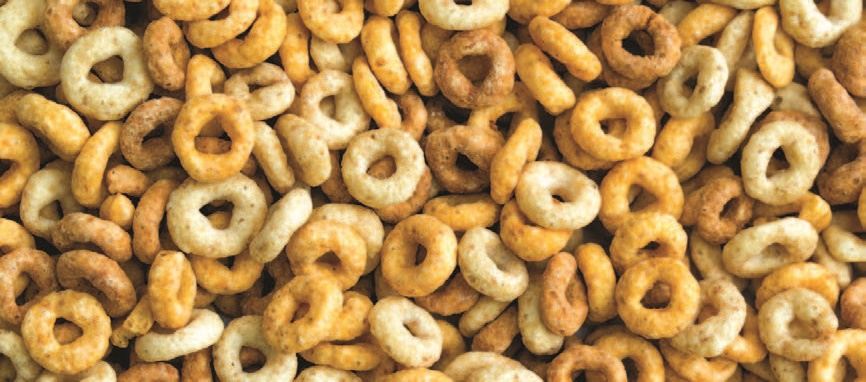Confessions of a cereal consumer.
By Mark Stewart
As a boy, I found milk to be utterly disgusting. I didn’t like the color, the taste, the smell or the texture. The bottles were too heavy and, when it started coming in cardboard, the opening never separated properly. All these years later, I honestly cannot remember drinking a glass of plain milk. Not that I didn’t—I’ve just tried really hard to bury that memory. Whenever I visited a friend’s house, I’d tell his parents preemptively that I was allergic to milk. One mom said, “Too bad, I poured it…you drink it.” Hello? Child Services?
Eventually I wore down my parents. The final peace treaty was that I didn’t have to drink milk if I consumed a bowl of cereal each morning. So of course I would pour as little milk as possible, sometimes just a drop or two. It took a couple of years, but I won and the adults stopped caring. The problem was that, by this point, I was kind of hooked on dry cereal. And here I am, a half-century later, still cleaving off from my spouse on our joint supermarket trips to explore the breakfast aisle looking for interesting boxes to stash in the pantry.
I say this unabashed. Every so often, I need something sweet but not too sweet, with a good, eardrum-rattling crunch.
I suppose I’ve convinced myself that a handful of Honey Nut Cheerios is healthier than a handful of potato chips. Maybe they are. I really don’t know. What I do know is that, starting in the early 1960s and running right up to college in the late 1970s, I became something of a dry cereal aficionado. Or addict, if you prefer. I was on the winning side of Quisp vs. Quake and can still rattle off the jingles of defunct cereal brands. The human brain apparently has a mind of its own; I know this because after 10 years I still can’t remember my younger daughter’s phone number.
My babysitter was a Zenith 19-inch TV so I basically saw every cereal ad ever made, again and again and again. Cereal commercials from my youth employed myriad strategies to convince kids it was worth harassing their parents into buying this box or that. The “free toy inside” could be an effective sales tool, but the toys were always lame and if the cereal was, too, then you moved on pretty quickly. The most impactful cereal commercials were probably the ones that aired during morning cartoons, and were also cartoons themselves. A lot of these characters are still with us, as you know, but they’ve been cleaned up for 21st century sensibilities.
The Coco Puffs bird of my childhood (his name was Sonny) was severely ADHD; now he’s been effectively medicated, although the brown sugar-balls probably aren’t doing him any good.  The Lucky Charms leprechaun that the kids were always trying to catch sounded like the kind elderly first-generation Irish gentle- men who lived in my neighborhood. But “Lucky” sure didn’t look like them. As I got older, I realized he was a racist caricature that had barely been updated since the 1800s. Lucky Charms are still around, but the new guy on the box has been drawn with a bit more cultural sensitivity.
The Lucky Charms leprechaun that the kids were always trying to catch sounded like the kind elderly first-generation Irish gentle- men who lived in my neighborhood. But “Lucky” sure didn’t look like them. As I got older, I realized he was a racist caricature that had barely been updated since the 1800s. Lucky Charms are still around, but the new guy on the box has been drawn with a bit more cultural sensitivity.
Not for nothing, but what the devil were those marshmallow-dependent hoodlums planning to do to that poor leprechaun? I swear there was one commercial where they were trying to drown him in a well and take his cereal. Talk about crossing the line.
Actually, the cereal commercial I can’t quite get out of my head is a particular one for Sugar Pops. It was a live-action ad that featured a cowboy in a cornfield. He tosses an ear of corn in the air and cracks it with his whip, which creates a cascade of glazed yellow mini-boulders that fall neatly into the box. Oh…so that’s how they make those things. No one I knew could actually stand the cereal, but for several weeks the boys in my grade were obsessed with whipping things. I guarantee if I look these guys up on Facebook, one or two of them will still be into whips.
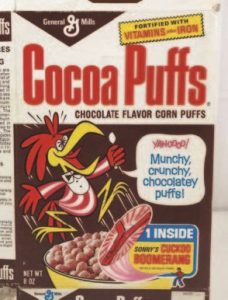 Like Coco Puffs and Lucky Charms, Sugar Pops are still around. I believe they are just called Pops these days. You see, a lot of cereals removed “sugar” from their names a few years ago. Who eats Pops now, I wonder? Arthur Fiedler fans? Because that’s kind of a limited market.
Like Coco Puffs and Lucky Charms, Sugar Pops are still around. I believe they are just called Pops these days. You see, a lot of cereals removed “sugar” from their names a few years ago. Who eats Pops now, I wonder? Arthur Fiedler fans? Because that’s kind of a limited market.
Many of the cereals of my youth came and went after brief, unsuccessful runs. I tried them all and remember most. After Hawaii was admitted to the union, Madison Avenue leveraged the state’s newfound celebrity and rebranded a number of consumer products. The one we all know is Hawaiian Punch, which actually played off the word “punch” more than “Hawaiian.” You’ll recall that every commercial was a textbook case of felony assault. At about the same time, Kellogg’s came out with Puffa-Puffa Rice, which was basically Rice Krispies sprayed with a brown sugar and honey after-coating. In the TV commercial, Hawaiian natives dumped bushels of rice into an active volcano, then hauled their grass-skirted butts off the mountain before it blew. And when it blew, it spewed out a delicious pyroclastic flow of the aforementioned puffed rice. As a dry cereal, it was sticky on the hands, but still pretty good. Puffa-Puffa Rice disappeared sometime in my teen years.
By then, I had been sucked in by a new genre of breakfast cereal: brand extensions of the actual cartoons we watched. Who didn’t love the Pink Panther, right? It was a fast-moving half-hour of clever, subversive unpredictable violence and fun—a perfect Saturday morning warm-up for a weekend with my family. Well then, who wouldn’t love Pink Panther Flakes? These were Frosted Flakes with an unhealthy dose of Red Dye #2 that made them glisten when the light caught them just right. The gimmick was that the cereal turned your milk pink. Well, that sounded disgusting to me and, apparently, it was, because it didn’t even outlast the cartoon.
I mentioned the Quisp and Quake feud earlier. This was a brilliant piece of marketing. Kids didn’t have much say in anything back then. The idea that the “losing” cereal (it was Quake) would blip out of existence was incredibly empowering for a child. As the day of reckoning drew near, the tension was palpable. It was like watching returns in a razor-thin election, except it wasn’t for something stupid like governor or senator or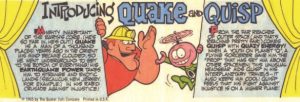 President of the United States. This was breakfast-table life and death. Most kids who tried both realized Quisp and Quake were essentially the same cereal, just different shapes: Quisp was an alien, so his shape was a flying saucer, while Quake was some sort of jackhammer operator, so his shape looked like chunks of construction material. Prior to the contest, they changed Quake to a cowboy or a safari guide or something that didn’t make much sense. Well, duh, you don’t do that so close to a national election. When the results were announced, Quisp won in a Nixon-like landslide, while Quake probably didn’t even win his home state.
President of the United States. This was breakfast-table life and death. Most kids who tried both realized Quisp and Quake were essentially the same cereal, just different shapes: Quisp was an alien, so his shape was a flying saucer, while Quake was some sort of jackhammer operator, so his shape looked like chunks of construction material. Prior to the contest, they changed Quake to a cowboy or a safari guide or something that didn’t make much sense. Well, duh, you don’t do that so close to a national election. When the results were announced, Quisp won in a Nixon-like landslide, while Quake probably didn’t even win his home state.
At about the same time—and I know that no one with a real job will remember this—there was another cereal feud trying to break through the noise. Borrowing from Quisp and Quake, while also riffing off of Snoopy and the Red Baron in the Peanuts cartoon strip, were a pair of World War I fighter pilots, Baron von Redberry and Sir Grapefellow. Grapefellow was a Brit, while von Redberry broke Teutonic. With the older brothers and cousins of kids you knew coming back from Vietnam not quite whole anymore (or not at all), what better way to sell breakfast cereal than by celebrating a conflict that killed 20 million people? Not surprisingly, both pilots crashed and burned shortly after takeoff, but let me tell you…the grape flavor was a bold move and I thought it was one of the great dry cereals.
Incidentally, as a child and, yes, as an adult, I put bananas in the same category as milk, a category I call “Nope. Nope. Nope.” My parents loved to slice bananas directly onto their cereal. It was horrifying to me on a molecular level. The only upside was that I knew for sure they were telling me the truth about my being adopted.
Cereal makers tried again and again to come up with products that approximated the taste of freshly sliced bananas—sometimes with an artificial spray or flavoring, sometimes with freeze-dried pieces that reconstituted into banana mush when bathed in milk. The summer I turned seven, I noticed Kellogg’s Corn Flakes with Instant Bananas during a supermarket visit. Naturally, the concept was disgusting to me…but at the same time oddly intriguing. Maybe, I thought, crunchy freeze-dried bananas would work for me as a milk-less cereal. I stared at the box for a long time, which is how you make buying decisions at that age. The character on the front was a banana-man with a windbreaker formed by his own banana peel. I think he also had a hat tilted at a slightly rakish angle. Well, he seemed like a decent enough guy, so I snuck it into the cart.
At the checkout register, my mother did a double-take when I placed the box on the conveyer belt. She squinted at me, looked back at the banana-man, squinted at me again hard, and then sighed and said, “Okay.” I knew what that meant: She thought I’d consume one dry handful, make a fake gagging sound and then throw it away (and within an hour she would be proved correct). Mom could have started a public confrontation, and it wouldn’t have been her first, but apparently that was not the hill she planned to die on that day.
So recently I encountered a box of Kellogg’s Corn Flakes with Instant Bananas for sale on eBay. In retrospect, I see that the banana-man definitely had a registered sex offender vibe. I wonder if that’s why my mother was squinting at me. Anyway, I still buy the occasional box of “healthy” cereal now with banana bits, which are still a thing, ever hopeful that my taste buds have matured. Sadly, they have not. Dried bananas still make me fake-gag.
Meanwhile, my quest for another grape-flavored cereal continues. (Shame on you, Grape Nuts, by the way, for teasing me my whole adult life). Blueberry Cheerios, which I picked up on sale at a CVS recently, came pretty close flavor- and crunch-wise to what I was looking for, but they fell short. I suspect that they will be on sale forever, because they don’t taste much like anything found in nature and have the additional disadvantage of approximating the color of death.
Another cereal I encountered recently while shopping for something else was an old favorite, Alpha-Bits. I flashed back to what I believe to have been the first time that I made someone laugh with words I wrote. I was six years old and, okay, it was one word. And it’s a word we can’t print in this magazine. And it was a word I assembled on a spoon, not one I wrote on paper.
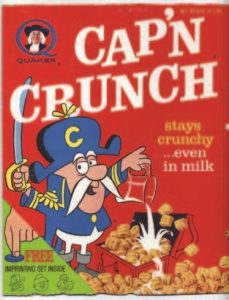 So let’s finish up with Cap’n Crunch. In terms of mouth feel, the folks who made this cereal really got me. Even as a pre-schooler, I understood that “staying crunchy even in milk” meant they would be super-crunchy right out of the box. (Only later did I begin to wonder why the word “even” was part of the sell copy; was someone pouring something else on their cereal?) Well anyway, they were sensational. Even now, I have to talk myself out of a date with the Cap’n every time I go to the store. For the record, I preferred the original, unadulterated version, without the Crunchberries and all the stuff they’ve added since. I’ll bet there are a dozen different Cap’n Crunch flavors right now. I should state here that I don’t eat Cap’n Crunch anymore and haven’t had a handful probably since the 1980s. It’s not because they are too sweet (which they are) or too crunchy (which they aren’t) or that the insane sugar rush one experiences while consuming them would have enabled Jean LaFoot’s fellow Frenchmen to hold the Maginot Line. I think it’s about how Cap’n Crunch affected the way I viewed my father.
So let’s finish up with Cap’n Crunch. In terms of mouth feel, the folks who made this cereal really got me. Even as a pre-schooler, I understood that “staying crunchy even in milk” meant they would be super-crunchy right out of the box. (Only later did I begin to wonder why the word “even” was part of the sell copy; was someone pouring something else on their cereal?) Well anyway, they were sensational. Even now, I have to talk myself out of a date with the Cap’n every time I go to the store. For the record, I preferred the original, unadulterated version, without the Crunchberries and all the stuff they’ve added since. I’ll bet there are a dozen different Cap’n Crunch flavors right now. I should state here that I don’t eat Cap’n Crunch anymore and haven’t had a handful probably since the 1980s. It’s not because they are too sweet (which they are) or too crunchy (which they aren’t) or that the insane sugar rush one experiences while consuming them would have enabled Jean LaFoot’s fellow Frenchmen to hold the Maginot Line. I think it’s about how Cap’n Crunch affected the way I viewed my father.
My dad piloted bombers during World War II and attained the rank of captain. That’s pretty much all I knew about his military service as a a little boy. He didn’t talk about the war much, or what it was like to fly or even be a leader of men. The only story he liked to tell was about how he and a buddy were ordered to “police-up” a stretch of beach in Savannah as punishment for some minor transgression committed during flight training. They raked the debris into a large pile before realizing that they had no way of transporting it to the dump. Their ingenious solution was to soak the trash with aviation fuel, toss a match on the whole mess and get back to more pressing matters. The resulting explosion propelled them through the air, singed off their eyebrows and convinced everyone within a couple of miles that either a plane had crashed or some saboteurs were up to no good on the beach. My father would tell me this story whenever he was igniting charcoal for a summer barbecue—usually after
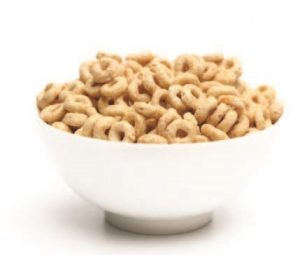
www.istockphoto.com
downing a couple of beers, with an open can of lighter fluid in his hand and a lit cigarette dangling from his lips.
At some point I made the connection between my father the Captain and Cap’n Crunch. I was five or six but I wasn’t an idiot. I recognized that Dad had been in the Army and, clearly, the Cap’n was a Navy man. But with their rank being identical, I began to question how and where my father’s military career had gone off the rails. He was by this time a newspaper editor, a job that was difficult for me to comprehend since I had only recently begun to read. (If he had edited Good Night, Moon obviously that would have been different). All I knew was that he didn’t have a big blue hat. He wasn’t on TV. He didn’t have his own ship. And he didn’t have his own cereal. What exactly had happened? Was it the garbage explosion in Savannah? Oh, my God. Was that what the barbecue story was really all about?
One morning I summoned the courage to confront my father at the breakfast table. He was consuming something unspeakable like liver and onions while I was fussing nervously with my bowl of Cap’n Crunch, moistened as usual with a half-ounce of milk. Without saying a word, I slid the box slowly to his side of the table. He looked at it for a long time, long enough so I knew I could open my line of questioning: “How come you were a captain and he’s a captain—”
My father tipped the box over so we could both see the front, pointed to the apostrophe in the top word and like an ex-officer and good editor, showed me something I had missed.
“He’s not a captain,” he pointed out in mid-chew. “He’s a Cap’n.”
His look said everything: Let us never speak of this again.
And sure enough, we never did.

